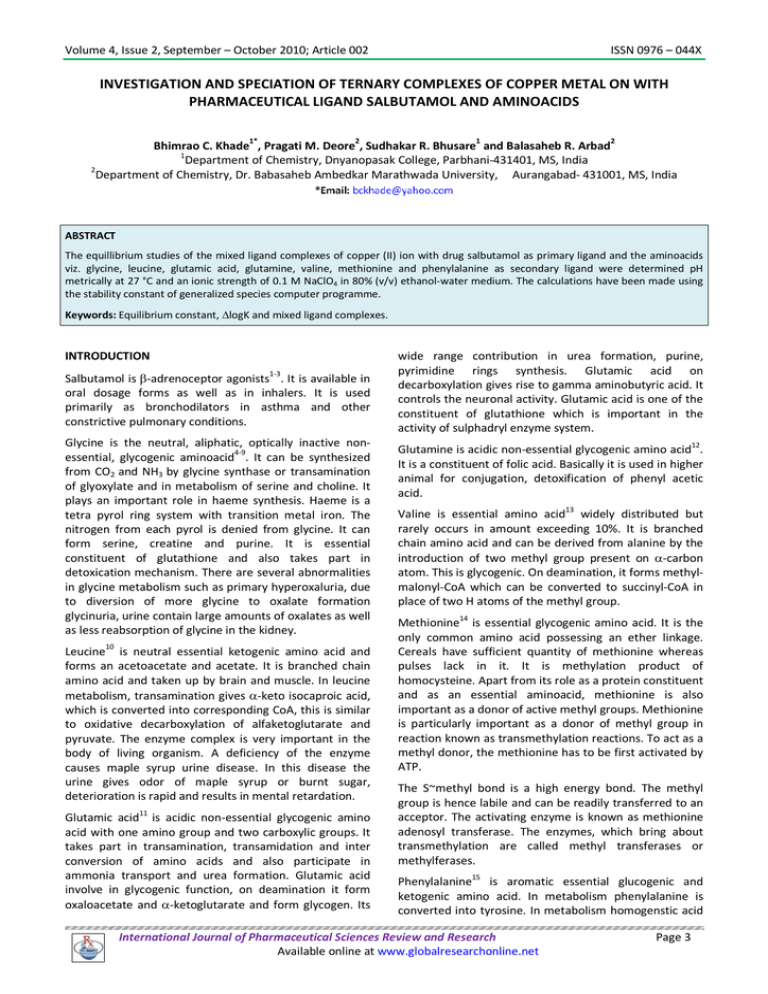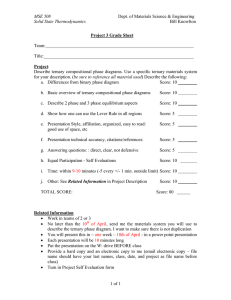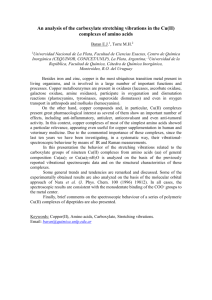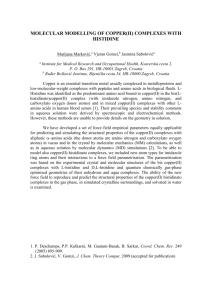Document 13308243
advertisement

Volume 4, Issue 2, September – October 2010; Article 002 ISSN 0976 – 044X INVESTIGATION AND SPECIATION OF TERNARY COMPLEXES OF COPPER METAL ON WITH PHARMACEUTICAL LIGAND SALBUTAMOL AND AMINOACIDS Bhimrao C. Khade1*, Pragati M. Deore2, Sudhakar R. Bhusare1 and Balasaheb R. Arbad2 1 Department of Chemistry, Dnyanopasak College, Parbhani-431401, MS, India 2 Department of Chemistry, Dr. Babasaheb Ambedkar Marathwada University, Aurangabad- 431001, MS, India ABSTRACT The equillibrium studies of the mixed ligand complexes of copper (II) ion with drug salbutamol as primary ligand and the aminoacids viz. glycine, leucine, glutamic acid, glutamine, valine, methionine and phenylalanine as secondary ligand were determined pH metrically at 27 °C and an ionic strength of 0.1 M NaClO4 in 80% (v/v) ethanol-water medium. The calculations have been made using the stability constant of generalized species computer programme. Keywords: Equilibrium constant, logK and mixed ligand complexes. INTRODUCTION 1-3 Salbutamol is -adrenoceptor agonists . It is available in oral dosage forms as well as in inhalers. It is used primarily as bronchodilators in asthma and other constrictive pulmonary conditions. Glycine is the neutral, aliphatic, optically inactive nonessential, glycogenic aminoacid4-9. It can be synthesized from CO2 and NH3 by glycine synthase or transamination of glyoxylate and in metabolism of serine and choline. It plays an important role in haeme synthesis. Haeme is a tetra pyrol ring system with transition metal iron. The nitrogen from each pyrol is denied from glycine. It can form serine, creatine and purine. It is essential constituent of glutathione and also takes part in detoxication mechanism. There are several abnormalities in glycine metabolism such as primary hyperoxaluria, due to diversion of more glycine to oxalate formation glycinuria, urine contain large amounts of oxalates as well as less reabsorption of glycine in the kidney. 10 Leucine is neutral essential ketogenic amino acid and forms an acetoacetate and acetate. It is branched chain amino acid and taken up by brain and muscle. In leucine metabolism, transamination gives -keto isocaproic acid, which is converted into corresponding CoA, this is similar to oxidative decarboxylation of alfaketoglutarate and pyruvate. The enzyme complex is very important in the body of living organism. A deficiency of the enzyme causes maple syrup urine disease. In this disease the urine gives odor of maple syrup or burnt sugar, deterioration is rapid and results in mental retardation. Glutamic acid11 is acidic non-essential glycogenic amino acid with one amino group and two carboxylic groups. It takes part in transamination, transamidation and inter conversion of amino acids and also participate in ammonia transport and urea formation. Glutamic acid involve in glycogenic function, on deamination it form oxaloacetate and -ketoglutarate and form glycogen. Its wide range contribution in urea formation, purine, pyrimidine rings synthesis. Glutamic acid on decarboxylation gives rise to gamma aminobutyric acid. It controls the neuronal activity. Glutamic acid is one of the constituent of glutathione which is important in the activity of sulphadryl enzyme system. Glutamine is acidic non-essential glycogenic amino acid12. It is a constituent of folic acid. Basically it is used in higher animal for conjugation, detoxification of phenyl acetic acid. Valine is essential amino acid13 widely distributed but rarely occurs in amount exceeding 10%. It is branched chain amino acid and can be derived from alanine by the introduction of two methyl group present on -carbon atom. This is glycogenic. On deamination, it forms methylmalonyl-CoA which can be converted to succinyl-CoA in place of two H atoms of the methyl group. 14 Methionine is essential glycogenic amino acid. It is the only common amino acid possessing an ether linkage. Cereals have sufficient quantity of methionine whereas pulses lack in it. It is methylation product of homocysteine. Apart from its role as a protein constituent and as an essential aminoacid, methionine is also important as a donor of active methyl groups. Methionine is particularly important as a donor of methyl group in reaction known as transmethylation reactions. To act as a methyl donor, the methionine has to be first activated by ATP. The S~methyl bond is a high energy bond. The methyl group is hence labile and can be readily transferred to an acceptor. The activating enzyme is known as methionine adenosyl transferase. The enzymes, which bring about transmethylation are called methyl transferases or methylferases. Phenylalanine15 is aromatic essential glucogenic and ketogenic amino acid. In metabolism phenylalanine is converted into tyrosine. In metabolism homogenstic acid International Journal of Pharmaceutical Sciences Review and Research Available online at www.globalresearchonline.net Page 3 Volume 4, Issue 2, September – October 2010; Article 002 ISSN 0976 – 044X is formed which undergoes cleavage and form fumarate and acetoacetate. The hormones such as adrenaline, noradrenaline, thyrosine and melanin pigment formed from tyroxine. Several abnormalities observed in phenylanine metabolism such as phenylketonaria and alkaptonaria. In phenylketonaria, there is a black in hydroxylation of phenyl alanine to form tyrosine, this leads to mental retardation. Alkeptanaria, in this homogenstic acid is not further oxidised and excreted in urine, which lead to black coloration of urine. complexes of salbutamol with copper (II) in the presence of aminoacids in 80%(v/v) ethanol-water medium at 27 °C at a fixed ionic strength 0.1 M NaClO4. Copper is a transition metal ion and is used by various enzymes in the body in different biochemical reactions. These reactions may be creating energy, decreasing the body’s inflammatory blood clotting16 etc. Copper is absorbed by the body at two main sites such as small intestine and stomach. Copper does not float through the blood stream as copper ion but is carried by proteins. Two main carrier proteins especially for copper are ceruloplasmin17 and albumin; these can carry many things including copper. Copper is stored in proteins called metallothione18-19. Enzymes are proteins specialized to assist in a chemical function. Copper is needed by enzymes as a helper in a chemical reaction. This function makes copper essential for cytochrome C oxidase, essential for energy and superoxide dismutase essential oxidative tissue damage etc. In recent years it has been proved that transition metals like copper is essential for normal development and function of human cells. Disruption of copper metabolism causes severe neurodegenerative disease, such as Willson’s disease20-24, and Menke’s disease25-27 with symptoms that range from psychiatric abnormalities and motor dysfunction, to poor temperature control and liver and kidney abnormalities. Survey of literature reveals that no work has been reported on complex tendencies of drug salbutamol with transition metal ion copper (II) in ethanol-water solution. Therefore in order to understand the complex formation tendencies of salbutamol it was though worthwhile to determine the formation constant 1:1:1 ternary MATERIALS AND METHODS Drug sample of salbutamol in pure form were obtained from pharma industries and used as received. Ethanol was purified as described in literature28. Double distilled water was used for the preparation of ethanol-water mixture and stock solution of salbutamol. All chemicals used were AnalaR grade. NaClO4 (0.1M) and NaOH solution was prepared in carbondioxide free double distilled water. Carbonate free NaOH was standardized by titrating with oxalic acid. HClO4 Reidal (Germany) was used for the preparation of the stock solutions of copper (II) to prevent hydrolysis and standardized by using 29 standard EDTA solution . The experimental procedure, in the study of ternary chelated by the potentiometric titration technique, involves the titration of carbonate free solution of Free HClO4(A) Free HClO4 + Ligand salbutamol Drug Free HClO4 + Ligand salbutamol + Metal ion Free HClO4 + Ligand Aminoacids Free HClO4 + Ligand Aminoacids + Metal Ion Free HClO4 + Ligand Drug + Ligand Aminoacids + Metal Ion Against standard solution of sodium hydroxide, were drug salbutamol and aminoacid are two ligands. The ionic strength of the solutions was maintained constant i.e. 0.1M by adding appropriate amount of 1M sodium perchlorate solution. The titration were carried out at 27 °C in an inert atmosphere by bubbling oxygen free nitrogen gas through an assembly containing the electrode to expel out CO2. pH meter reading in 80% (v/v) ethanol-water were corrected by method of Vanuitert and Hass30. The formation constant of ternary complexes were determined by computational programme SCOGS31 to minimize the standard derivation. Table 1: The proton ligand constant and metal ligand stability constant of salbutamol and amino acids with copper (II) determined in 80% (v/v) ethanol-water mixture at 27 °C and ionic strength = 0.1M NaClO4. [Medium 80% (V/V) EthanolWater Medium; E0 = 2.173 x 10-2 M; T0L = 2 x 10-3 M; V0 = 50 ml; = 0.1 M NaClO4; T0M = 4 x 10-4; NaOH = 0.4347 N; Temp 27 °C + 0.1 °C] Copper Ligands PK1 PK2 Logk1 LogK2 Salbutamol 10.1995 -2.7763 -Glycine 2.7700 9.7400 9.6900 8.9800 Leucine 3.8100 10.340 8.0703 Glutamic Acid 3.1360 5.8987 10.980 8.6400 Glutamine 3.0100 9.2800 9.5400 7.8900 Valine 3.2100 9.8024 10.010 8.4800 Methionine 3.1200 9.6000 9.6400 8.6700 Phenylalanine 3.1400 9.3000 8.9900 7.6700 International Journal of Pharmaceutical Sciences Review and Research Available online at www.globalresearchonline.net Page 4 Volume 4, Issue 2, September – October 2010; Article 002 ISSN 0976 – 044X Table 2: Parameters based on some relationship between the formation of ternary complexes of copper (II) metal ion with salbutamol in the presence of amino acids (1:1:1) system. [Temp = 27 °C; I = 0.1 M NaClO4; Medium = 80% (V/V) Ethanol-Water] AMINOACIDS 11 02 20 KD KR Kr logK Glycine 12.4680 18.67 2.7783 9.6897 2.7780 1.1620 -0.0003 Leucine 9.5250 08.07 2.7783 6.7467 1.4547 1.7559 -1.3236 Glutamic Acid 13.2590 19.62 2.7783 10.4807 2.2790 1.1839 -0.4993 Glutamine 12.3180 17.43 2.7783 9.5397 2.7780 1.2191 -0.0003 Valine 12.7890 18.49 2.7783 10.0107 2.7790 1.2026 0.0007 Phenylalanine 12.1400 18.31 2.7783 9.3617 2.5000 1.1513 -0.2783 Phenylalanine 10.9900 16.66 2.7783 8.2207 2.0000 1.1316 -0.7693 RESULTS AND DISCUSSION a) Binary Metal Complexes The proton ligand constant and metal ligand stability constant of salbutamol and amino acids with copper (II) determined in 80% (v/v) ethanol-water mixture at 27 °C and ionic strength = 0.1M NaClO4 are given in Table-132. b) Ternary Metal Complexes In the ternary systems, the mixed ligand titration curve coincide with acid + drug complex curve up to the pH 2.4 and after this pH, it deviates. Theoretical composition curve remains toward left to the mixed ligand titration complex curve. After pH 2.5, the mixed ligand curve drift towards X axis, indicating the formation of hydroxide species. Since the mixed ligand curve coincide with individual metal complex titration curves, the formation of 1:1:1 complex by involving stepwise equilibria. The Primary ligand salbutamol form 1:1 and secondary ligand amino acids such as glycine, leucine, glutamic acid, glutamine, valine, methionine and phenylalanine form 1:1 and 1:2 complexes with Cu(II). It is evident from the figure of the percentage concentration species Cu(II)salbutamol- amino acids system, that the percentage distribution curve of free metal decreases sharply with increasing pH. This indicates involvement of metal ion in the complex formation process. Percentage concentration of free ligand salbutamol and aminoacids increases and this increase may be due to the dissociation of excess ligand present in the system, as a function of pH. formation of Cu(II)-salbutamol-glycine and represented by C7. The concentration of this species continuously increases; confirm the formation of ternary complexes. SCOG distribution curve of ternary system Cu(II)salbutamol-glycine showed that the formation of ternary complex started at pH ~ 2.7 when Cu(II) at pH ~ 4.7. Ternary complexes attain their maximum concentration in the pH ~4.2. From the SCOG distribution curve it is concluded that the formation of ternary complex started only after the metal-primary ligand complex has attained its maximum concentration. This indicates that the metalprimary ligand complex Cu(II)-salbutamol is formed first and then the secondary ligand Cu(II)- glycine coordinated to it, resulting the formation of ternary complex. According to this method in this system ternary complex of salbutamol with glycine, glutamicacid, glutamine, valine, methionine and phenylalanine show the following types of the concentration species distribution. Species Distribution Studies: To visualize the nature of the equilibria and to evaluate the calculated stability constant of ternary complexes Cu(II)-salbutamol-glycine, species distribution curves have been plotted as a function of pH at temperature 27°C and = 0.1 M NaClO4 using SCOG program. According to this method in this system ternary complex of salbutamol with leucine show the following types of the concentration species distribution. It can be seen that, the concentration of Cu(II)salbutamol-glycine increases from pH~2.7, whereas the concentration for the formation of D (drug) and HR (amino acid) represented by C1 and C2 show continuous decrease with increasing pH which indicates the International Journal of Pharmaceutical Sciences Review and Research Available online at www.globalresearchonline.net Page 5 Volume 4, Issue 2, September – October 2010; Article 002 ISSN 0976 – 044X The positive value of logK indicates the equilibrium is more on its right side. The other characterization is based on the disproportion reaction represented by the following equilibrium; The disproportion reactions for the system containing the ligands which form 1:1 and 1:2 complexes individually with the metal ion are as Where M = Metal, R= Aminoacids and D = salbutamol Moreover, the maximum percentage of the formation of ternary complexes is less than that of the Cu(II)- glycine binary complex; and more than Cu(II)-salbutamol binary complex, this indicates that the ternary complex is less stable as compared to Cu(II)- glycine binary complex and more stable than Cu(II)-salbutamol binary complex. The relative stabilities of the binary and ternary complexes are quantitatively expressed in term of 11, 20, 02, KD, KR, Kr and logK value which are represented in Table-2. The stability constants of ternary systems are represented in Table-2. Above two reactions are for the system containing one ligand which form only 1:1 and other form both 1:1 and 1:2 binary complexes. The last reaction is for the system containing ligands which form only 1:1 binary complexes. The magnitude of the constant is the measure of stability of mixed ligand complexes. Watter and Kida calculated statistically expected value 0.6 log unit by considering with probabilities for a variety of reason discussed by Sigel. logK value can be calculated by using first or second approach. The calculated logK values for all systems are given in Table-2 The stability of ternary complexes is conveniently characterizes by two ways, one based on difference of stability constant log K and second disproportion constant. In Cu (II)- salbutamol -aminoacids, primary ligand salbutamol form only 1:1 and secondary ligand form both 1:1 and 1:2 binary complexes. Therefore these systems favour the following disproportion reactions. The Stability Constant of Ternary Complexes With respect to the availability of coordination sites for ligand D in MR or MD. Generally KML1 KML2 because more coordination positions are normally available for bonding first ligand to a metal ion than the second ligand. Evidently KML1 KML2 or log K is negative. log K can be calculated by the expression. The negative log K for ternary systems indicates that the primary ligand anion and secondary ligand anions preferentially form ternary complexes to their binary ones. It follows from above expression that the difference, logK results from the subtraction of two constants and therefore, a constant which corresponds the equation, The Comparison of 11 with 20 and 02 of this system show that preferential formation of ternary complexes over binary complex of primary as well as secondary ligand. The considerably low value of KD and KR indicates less stability of ternary complexes with respect to that of primary as well as secondary ligands. The Kr value of this complex is positive but less which indicates lower stability of ternary complexes. Results of the present investigations show that the stability constant of ternary complexes formed are less stable. The negative logK value of this system indicates that the ternary complex is less stable than the binary 1:1 metal – salbutamol and metal – aminoacids complex. This is in accordance with statistical considerations. The negative value of logK does not mean that the complex is not formed. The negative value may be due to the higher stability of its binary complexes, reduced number 32-36 of coordination sites, steric hindrance , electronic 37-38 consideration , difference in bond type, geometrical structure etc. International Journal of Pharmaceutical Sciences Review and Research Available online at www.globalresearchonline.net Page 6 Volume 4, Issue 2, September – October 2010; Article 002 Sigel concluded that in the case of bidentate ligand Salbutamol and amino acid, there are twelve edges of a regular octahedron available to the first entering ligand but only five for the second. Then the statistical factor would be 5/12 and accordingly logK= -0.4, -0.6 and -0.9 for square planer and distorted octahedral complexes. Hence the experimentally determined value logK -0.6 indicate less stabilization in ternary complexes. The larger size of salbutamol may be responsible in decreasing the stability of ternary complexes as indicted by more negative logK value. The conclusion drawn from the pattern of the different species distribution curves for glycine, similarly for other amino acids. The stability of ternary complexes are governed by the nature of both, the primary and secondary ligand. The ligand first bound to metal ion influence the bonding properties of secondary ligands to be bound. The stabilization of ternary can be governed by bounding properties of secondary ligand. The order of stability of ternary of ternary complexes of Cu(II) with respect to secondary ligands for salbutamol are; Salbutamol= Valine > Glycine Glutamine > Methionine > Gluta. acid > Phenylalanine > Leucine The values of Kr (Statistical relationship) is presented in Table-2, which indicates the measure of relative stability of a mixed-ligand complexes with respect over all stabilities of binary complexes. From Table-2 it is observed that logK values for all the systems are negative, as already discussed that the negative logK values for ternary systems indicates less stability of complexes. ISSN 0976 – 044X 5. Doolittle RF, Myelin basic protein (MBP) is located at the interface of cytoplasm and membranes of central, Protein. Sci. Amer. 253(4), (1985), 88-89. 6. Block RJ, Bolling D, The amino acid composition of nd protein and foods, 2 ed. Thomas, Springfield, (1951), 111. 7. Edsall TT, Wyman J, Pseudomonas aeruginosa peptide peptidohydrolase, Biophysical Chemistry, 1, Acad. Pr. N.Y. (1958). 8. Florkin M, Stotz EH, (Eds.), Comprehensive biochemistry, Vol. 7 (Proteins) Elsevier, Amsterdam (1963). 9. Rama Rao AVSS A text book of biochemistry, 9 ed. (2002). th 10. Schonheimer R, The dynamic state of body constituent, Harvard Univ. Pr. Cambridge (Mass) (1942). nd 11. Meister A, Biochemistry of the amino acids, 2 ed., Vol-1 and 2 Acad. N.Y. (1965). 12. Damodaran M, Jaaback G, Chibnall AC, The metabolism of protein in green leaves, Biochem. J. 26, (1932), 1704. 13. Sangar F, Sequences, sequences and sequences, Ann. Rev. Biochem. 57, (1988), 1-28. 14. Mehlart A, Amino acid. Metabolism, A text book of biochemistry with clinical correlation, 3rd ed. (1992), 475-528. 15. Gross F, (ed), Protein metabolism, Springer Verlag OHG, Berlin, (1962). Acknowledgement 16. Peisachi J, Aisen P, Blumberg W, The biochemistry of copper, Acad., Per., N.Y. (1966). The authors very much thankful to the Dr. P. L. More, Principal, Dr. W. N. Jadhav, Head, Department of Chemistry and Dean of the Faculty, Dr. C. H. Gill for providing necessary facilities and UGC (WR) for financial assets under minor research project. 17. Nittis T, George GN, Winge DR, Yeasscol, A protein essential for cytochrome-C oxidase function is a Cu (I)-binding protein, J. BioChem. 276, (2001), 4252042526. REFERENCES 1. Goodman GA, Rall TW, Nies AS, Taylor P, The pharmacological basis of berapeutic, Elmsford, N.Y. (1990). 2. Boulton DW, Fawett JP, Enantioselective disposition of salbutamol in man, Br. J. Clin. Pharmacol. 41, (1996) 35-40. 3. Esquisabel A, Hernandez RM, Gascon AR, Igartua M, Calvo B, Pedraz JL, Determination of salbutamol enantiomers by high-performance capillary, J. Pharma. Biomed. Anal. 16, (1997) 357-366. 4. Braconnot HG, The hydrolysis of protein, Ann. Chem. Phys. (2), 13, (1820), 113. 18. Heaton DN, George GN, Garrison G, Wing DR, The mitochondrial copper metallochaperone, Cox 17 exists as an Oligomeric, poly copper complex, Biochemistry, 40, (2001), 743-751. 19. Brown KR, Keller GL, Pickering IJ, Harris HH, George GN, Winge DR, The structure of the cuprous-thiolate clusters of the Ace1 and Mac1 trancriptional activators, Biochemistry, (2002), 41. 20. Tsivkovskii R, Efremov R, Lutsenko S, The role of the invariant his 1069 in folding and function of Wilson’s disease protein, the human copper transporting ATPase ATP7B, J. BioChem. 278, (2003), 13302-08. 21. Lutsenko S, Tsivkovskii R, Walker JM, Copper binding to the N-terminal metal-binding sites or the CPC, Ann. N.Y. Acad. Sci. 986, (2003), 204-11. International Journal of Pharmaceutical Sciences Review and Research Available online at www.globalresearchonline.net Page 7 Volume 4, Issue 2, September – October 2010; Article 002 ISSN 0976 – 044X 22. Didonato M, Hsum F, Narindrasorasak S, Que Jr. L., Sarkar B, J. Biol. Chem. 277 (16) (2002), 1340913414. 29. Moller M, Studies on aqueous solutions of the Iron thiocyanates, Dana Bogtrykkeri, Copenhagen, (1937). 23. Gerbasi V, Lutsenko S, Lewis EJ, A mutation in the ATP7B copper transporter causes reduced dopamine, Neurochem Res. 28, (2003), 867-73. 30. Laden IZ, The potentiometric determination of stability complexes, Phys. Chem. A 188, (1941), 160. 24. Hou ZJ, Narindrasorasak S, Bhushan B, Sarkar B, Mitra B, Introducing Wilson disease mutation into bacterial zinc, J. Biol. Chem. 276, (2001), 4085840863. 25. Sarkar B, Treatment of Wilson and Menke’s diseases medicinal inorganic chemistry, Chem. Rev. 99, (1999), 2535-2544. 26. Christodoulou J, Danks DM, Sarkar B, Baerlocher KE, Casey R, Horn N, Tumer Z, Clarke JTR, Defective copper-induced trafficking and localization of the Menkes protein in patients with mild and coppertreated classical Menkes disease, Am. J. Med. Genet-76, (1998), 154-164. 27. Tumer Z, Horn N, Tonnesen T, Christodoulou J, Clarke JTR, Sarkar B, Early copper-histidine treatment for Menkes disease, Nature Genetics, 12, (1996), 11-13. 28. Bjerrum J, Kgl Danske Videnskab, Selskab. Mat. Fys, Thermodynamics of complex equilibria in solution, Med. 11, No. 5 (1931); 11, No. 10 (1932); 12, No. 15 (1934). 31. Bjerrum J, Schwarzenbach G, Sillen LG, Stability constant part I, organic ligand; part II inorganic ligands, Chemical Society, London, (1957-58). 32. Khade BC, Deore PM, Arbad BR, Potentiometric studies on the stability constants of some drugs with copper (II), chromium (III) and calcium (II) in 80 %( v/v) ethanol-water medium, Acta Sciencia Indica, vol. XXXIIIC, No. 1.105. (2007). 33. Martell AE, Smith PM, Critical stability constants, Plenum Press, New York, (1976). 34. Martell AE, Calvin M, Chemistry of the metal chelate compounds, Prentice-Hall Inc, England (1962). 35. Beck MT, Chemistry of complex equilibrium, Van Mostrand Reinhold Company, London (1970). 36. Irving H, Rossotti H, The determination of stability constants, J. Chem. Soc. (1953), 3397. 37. Irving H, Rossotti H, The determination of stability constants, J. Chem. Soc., (1954), 2904. 38. Sigel H, Metal ions in biological systems, Marcel Dekker, Inc, New York, Vol. 1-4 (1973), Vol. 5, 6 (1976), Vol. 7-9 (1979). *********** International Journal of Pharmaceutical Sciences Review and Research Available online at www.globalresearchonline.net Page 8




